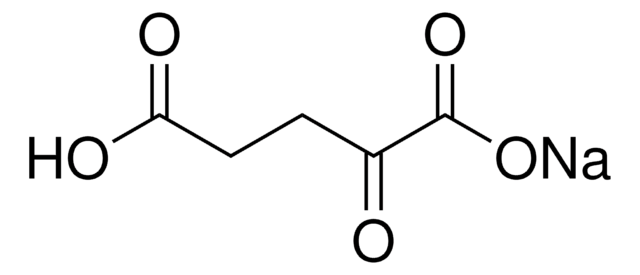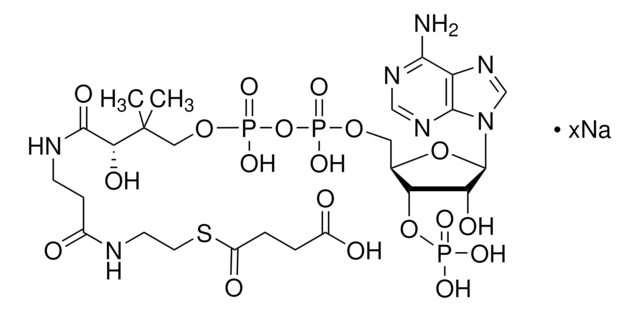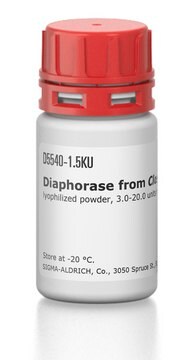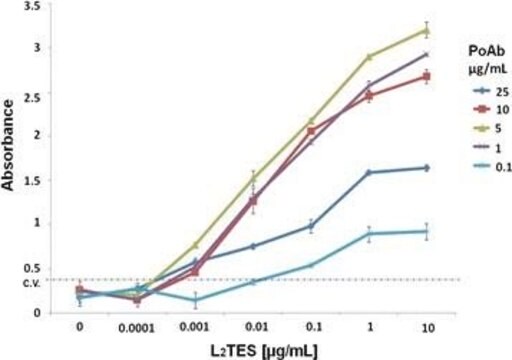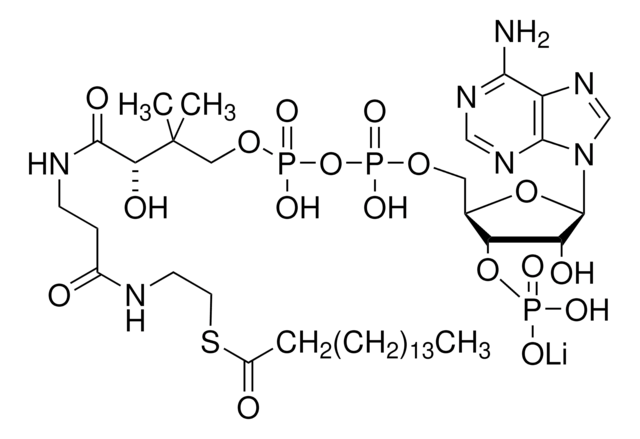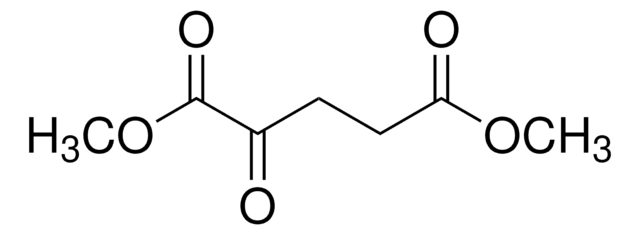K1502
α-Ketoglutarate Dehydrogenase from porcine heart
buffered aqueous glycerol solution, 0.1-1.0 units/mg protein (Lowry)
Sinonimo/i:
Multienzyme 2-oxoglutarate dehydrogenase complex
Autenticatiper visualizzare i prezzi riservati alla tua organizzazione & contrattuali
About This Item
Numero CAS:
Numero MDL:
Codice UNSPSC:
12352204
NACRES:
NA.54
Prodotti consigliati
Stato
buffered aqueous glycerol solution
Livello qualitativo
Attività specifica
0.1-1.0 units/mg protein (Lowry)
Attività estranea
pyruvate dehydrogenase ≤20%
Condizioni di spedizione
dry ice
Temperatura di conservazione
−20°C
Cerchi prodotti simili? Visita Guida al confronto tra prodotti
Descrizione generale
Research Area: Neuroscience
α-Ketoglutarate dehydrogenase (α-KGDH) is a multienzyme complex localized to the mitochondria. This integrated enzyme is made up of many units of thiamine pyrophosphate-dependent dehydrogenase (E1), dihydrolipoamide dehydrogenase (E3), and dihydrolipoamide succinyl transferase (E2).
α-Ketoglutarate dehydrogenase (α-KGDH) is a multienzyme complex localized to the mitochondria. This integrated enzyme is made up of many units of thiamine pyrophosphate-dependent dehydrogenase (E1), dihydrolipoamide dehydrogenase (E3), and dihydrolipoamide succinyl transferase (E2).
Applicazioni
α-Ketoglutarate Dehydrogenase from the porcine heart has been used:
- to study the reversal of nitration by glutathione (GSH) in peroxynitrite-treated cells
- to measure its activity by Spectramax M5 microplate spectrofluorimeter using heart mitochondria
- as a positive control to evaluate its activity in by Spectramax GEMINI EM fluorescence microplate reader using mice neurons
Azioni biochim/fisiol
α-Ketoglutarate dehydrogenase (α-KGDH) is a key enzyme of bioenergetic processes and a controlling unit of metabolic flux through the Krebs cycle or tricarboxylic acid (TCA) cycle. It catalyzes the oxidative decarboxylation of α-ketoglutarate (KG) to succinyl-CoA by releasing reduced nicotinamide adenine dinucleotide (NADH). It is the rate-limiting reaction of the TCA cycle. This reaction contributes to the electrons of the respiratory chain and requires thiamine pyrophosphate as a cofactor. The reduction of NAD (nicotinamide adenine dinucleotide) is observed to determine its reaction rate. α-KGDH from porcine has an optimum pH range of 6.6–7.4. This enzyme is inhibited by oxidative stress and results in a metabolic deficiency. However, α-KGDH is also known to produce reactive oxygen species (ROS) leading to oxidative stress. Defective or limited levels of α-KGDH cause several neurodegenerative diseases such as Alzheimer′s disease.
α-Ketoglutarate dehydrogenase is most responsive to alterations in the tumor microenvironment and contributes to the adaptive metabolic response in cancer. Inhibiting α-ketoglutarate dehydrogenase counteracts lung metastasis associated with breast cancer.
Qualità
May contain traces of polyethylene glycol.
Definizione di unità
One unit will convert 1.0 μmole of β-NAD to β-NADH per min at pH 7.4 at 30 °C in the presence of saturating levels of coenzyme A.
Stato fisico
Supplied as a 50% glycerol solution containing ~9 mg per mL bovine serum albumin, 30% sucrose, 1.5 mM EDTA, 1.5 mM EGTA, 1.5 mM 2-mercaptoethanol, 0.3% TRITON™ X-100, 0.003% sodium azide, and 15 mM potassium phosphate, pH 6.8.
Note legali
Triton is a trademark of The Dow Chemical Company or an affiliated company of Dow
Indicazioni di pericolo
Consigli di prudenza
Classi di pericolo
Aquatic Chronic 3
Codice della classe di stoccaggio
10 - Combustible liquids
Classe di pericolosità dell'acqua (WGK)
WGK 1
Punto d’infiammabilità (°F)
Not applicable
Punto d’infiammabilità (°C)
Not applicable
Dispositivi di protezione individuale
Eyeshields, Gloves, multi-purpose combination respirator cartridge (US)
Scegli una delle versioni più recenti:
Possiedi già questo prodotto?
I documenti relativi ai prodotti acquistati recentemente sono disponibili nell’Archivio dei documenti.
I clienti hanno visto anche
Wagner L Araújo et al.
The Plant cell, 24(6), 2328-2351 (2012-07-04)
Transgenic tomato (Solanum lycopersicum) plants expressing a fragment of the gene encoding the E1 subunit of the 2-oxoglutarate dehydrogenase complex in the antisense orientation and exhibiting substantial reductions in the activity of this enzyme exhibit a considerably reduced rate of
Tristan Wagner et al.
Chemistry & biology, 18(8), 1011-1020 (2011-08-27)
The α-ketoglutarate dehydrogenase (KDH) complex is a major regulatory point of aerobic energy metabolism. Mycobacterium tuberculosis was reported to lack KDH activity, and the putative KDH E1o component, α-ketoglutarate decarboxylase (KGD), was instead assigned as a decarboxylase or carboligase. Here
Shuyi Zhang et al.
Science (New York, N.Y.), 334(6062), 1551-1553 (2011-12-17)
It is generally accepted that cyanobacteria have an incomplete tricarboxylic acid (TCA) cycle because they lack 2-oxoglutarate dehydrogenase and thus cannot convert 2-oxoglutarate to succinyl-coenzyme A (CoA). Genes encoding a novel 2-oxoglutarate decarboxylase and succinic semialdehyde dehydrogenase were identified in
Casey L Quinlan et al.
The Journal of biological chemistry, 289(12), 8312-8325 (2014-02-12)
Several flavin-dependent enzymes of the mitochondrial matrix utilize NAD(+) or NADH at about the same operating redox potential as the NADH/NAD(+) pool and comprise the NADH/NAD(+) isopotential enzyme group. Complex I (specifically the flavin, site IF) is often regarded as
Gary E Gibson et al.
Journal of neurochemistry, 134(1), 86-96 (2015-03-17)
Reversible post-translation modifications of proteins are common in all cells and appear to regulate many processes. Nevertheless, the enzyme(s) responsible for the alterations and the significance of the modification are largely unknown. Succinylation of proteins occurs and causes large changes
Il team dei nostri ricercatori vanta grande esperienza in tutte le aree della ricerca quali Life Science, scienza dei materiali, sintesi chimica, cromatografia, discipline analitiche, ecc..
Contatta l'Assistenza Tecnica.
